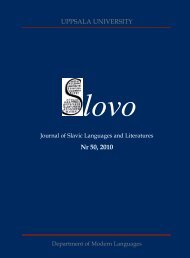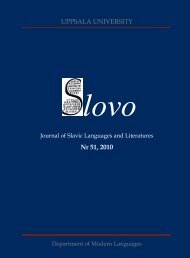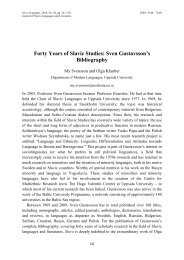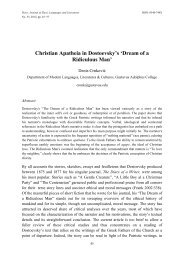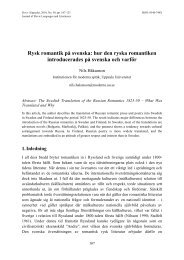Full text PDF - Index of - Uppsala universitet
Full text PDF - Index of - Uppsala universitet
Full text PDF - Index of - Uppsala universitet
You also want an ePaper? Increase the reach of your titles
YUMPU automatically turns print PDFs into web optimized ePapers that Google loves.
Slovo. Journal <strong>of</strong> Slavic Languages and Literatures ISSN: 0348-744X<br />
No. 52, 2011, pp. 113–114<br />
News from <strong>Uppsala</strong><br />
A recent dissertation titled Polsk poesi under mellankrigstiden:<br />
ett paradigmskifte. Exempel marialyriken<br />
(Polish Interwar Poetry: A Paradigm Shift. The Case <strong>of</strong><br />
Marian Lyrics) has been publically defended by<br />
Marousia Ludwika Korolczyk. Details about the<br />
event, including an abstract, are given bellow.<br />
The dissertation was publicly examined on December 10 th , 2011, in Ihre Hall, Centre<br />
for the Humanities, <strong>Uppsala</strong> University. The defense was conducted in Swedish.<br />
Abstract<br />
Korolczyk, M. L. 2011: Polish Interwar Poetry: A Paradigm Shift. The Case <strong>of</strong> Marian<br />
Lyrics. (Polsk poesi under mellankrigstiden: ett paradigmskifte. Exempel<br />
marialyriken.) Norma, Skellefteå. 226 pp. <strong>Uppsala</strong> ISBN 978 91 7217 094-8.<br />
The dissertation examines how medieval poetic tradition was reactivated in the<br />
production <strong>of</strong> poetry from the period between the two world wars—the Polish interwar<br />
period, defined here as one <strong>of</strong> literary transition. The positioning in regard to certain<br />
literary conventions and the quest for a new normativity that is so prevalent in interwar<br />
poetry is also reflected in the era’s poetry on the theme <strong>of</strong> Mary. Marian lyrics, owing<br />
to their strong position in Polish literature (but also by dint <strong>of</strong> their role in Polish piety<br />
and national identity), serve as an indicator in identifying and defining certain poetic<br />
processes. Central to this are the respective relationships <strong>of</strong> Marian themes to tradition<br />
and to the poetic norms <strong>of</strong> the era: is a given poem located along the traditional axis (if<br />
so, which), does it run counter to it, or is it an innovation?<br />
The poems analysed—Julian Przyboś’ Heavenly Blue, Jerzy Liebert’s Litany to the<br />
Virgin Mary, Tytus Czyżewski’s De pr<strong>of</strong>undis, Maria Pawlikowska-Jasnorzewska’s<br />
The Black Portrait, Józef Czechowicz’ pious rhymes—represent disparate poetic<br />
models: the Krakow Avant-garde, Catholic literature, formism/futurism, the circle <strong>of</strong><br />
Skamander, the Poetics <strong>of</strong> the Third Sphere in the Second Avant-garde. Reflected here<br />
is the broad spectrum <strong>of</strong> the period’s poetic trends, tendencies, and constellations—as<br />
are the historical and literary events <strong>of</strong> the era. Despite important differences in the<br />
poetic/aesthetic models, in these poems it is possible to identify shared characteristics<br />
relevant to this study, that is, elements <strong>of</strong> medieval poetry. The identifying criterion for<br />
these elements here is the concept <strong>of</strong> dogmatic formal language. In the poems<br />
113



